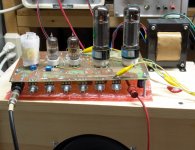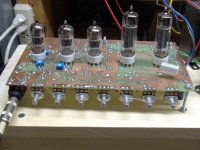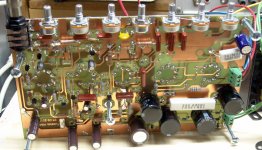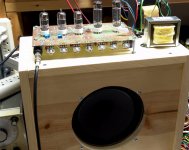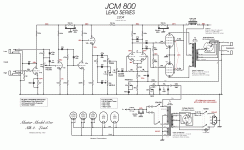Dear DIYaudios,
May I submit a project to your watchful eyes? It's something I've been planning a long time, and I think it's time I actually gather my wits and try to build it.
I want this to be the base for twiddling as many knobs and switches as possible to be able to experiment with voicing and sound generation in an amp. In the case of a good outcome I want to build a few stripped-down versions of this with what I learned from this particular monster as background.
I attached the current schematic for this.
There's some points I should make clear beforehand: The "BOOST" double-throw is actually a relay, all other switches are the common kind, the "BIAS" switch will only be toggled when power is off. The base for all this mayhem are Merlin B.s excellent Universal PCBs since I come from stompboxes and so I'm used to PCBs. I'm willing to expand my preciously little knowledge in the fields of point-to-point and other advanced techniques, but for this I feel I'm safer with those I feel comfortable with.
If you would cast a scrutinizing eye on my project to help me find fatal flaws in the contruct I'd be very glad! Thank you in advance whoever gives this a once-over!
May I submit a project to your watchful eyes? It's something I've been planning a long time, and I think it's time I actually gather my wits and try to build it.
I want this to be the base for twiddling as many knobs and switches as possible to be able to experiment with voicing and sound generation in an amp. In the case of a good outcome I want to build a few stripped-down versions of this with what I learned from this particular monster as background.
I attached the current schematic for this.
There's some points I should make clear beforehand: The "BOOST" double-throw is actually a relay, all other switches are the common kind, the "BIAS" switch will only be toggled when power is off. The base for all this mayhem are Merlin B.s excellent Universal PCBs since I come from stompboxes and so I'm used to PCBs. I'm willing to expand my preciously little knowledge in the fields of point-to-point and other advanced techniques, but for this I feel I'm safer with those I feel comfortable with.
If you would cast a scrutinizing eye on my project to help me find fatal flaws in the contruct I'd be very glad! Thank you in advance whoever gives this a once-over!
Attachments
I went down a similar road only to find that I put too much gain in one box. The amp was so microphonic that you could talk to the input tube and hear your voice in the speaker, and I only had 4 gain stages before the PI, you have 6.
I didn't use 12AX7's either, I used a cheap tube with about half the gain of a 12AX7.
I would build the back half of this gain monster first and get it working by plugging the guitar in where the FX return jack is now. Once that is stable and you are happy with it add one more gain stage at a time, tame it, then go further.
See if you can Google up the schematic of the Soldano SLO 100. It has a bunch of gain stages, but tricks like 470K grid stoppers are used to tame the total gain and roll off the highs to kill the hiss. Each stage had different tricks used to make the whole amp stable, and LDR are used in place of the relays to bypass gain stages as needed.
I wound up doing things to reduce the gain of three stages and totally bypass another to get an amp that I liked. There were two versions of this amp. Note that I had to wrap the input tube in styrofoam to keep the microphonics down on the EL34 version. I could get a monster feedback without even plugging in the guitar.
I didn't use 12AX7's either, I used a cheap tube with about half the gain of a 12AX7.
I would build the back half of this gain monster first and get it working by plugging the guitar in where the FX return jack is now. Once that is stable and you are happy with it add one more gain stage at a time, tame it, then go further.
See if you can Google up the schematic of the Soldano SLO 100. It has a bunch of gain stages, but tricks like 470K grid stoppers are used to tame the total gain and roll off the highs to kill the hiss. Each stage had different tricks used to make the whole amp stable, and LDR are used in place of the relays to bypass gain stages as needed.
I wound up doing things to reduce the gain of three stages and totally bypass another to get an amp that I liked. There were two versions of this amp. Note that I had to wrap the input tube in styrofoam to keep the microphonics down on the EL34 version. I could get a monster feedback without even plugging in the guitar.
Attachments
I went down a similar road only to find that I put too much gain in one box. The amp was so microphonic that you could talk to the input tube and hear your voice in the speaker, and I only had 4 gain stages before the PI, you have 6.
I didn't use 12AX7's either, I used a cheap tube with about half the gain of a 12AX7.
I would build the back half of this gain monster first and get it working by plugging the guitar in where the FX return jack is now. Once that is stable and you are happy with it add one more gain stage at a time, tame it, then go further.
See if you can Google up the schematic of the Soldano SLO 100. It has a bunch of gain stages, but tricks like 470K grid stoppers are used to tame the total gain and roll off the highs to kill the hiss. Each stage had different tricks used to make the whole amp stable, and LDR are used in place of the relays to bypass gain stages as needed.
I wound up doing things to reduce the gain of three stages and totally bypass another to get an amp that I liked. There were two versions of this amp. Note that I had to wrap the input tube in styrofoam to keep the microphonics down on the EL34 version. I could get a monster feedback without even plugging in the guitar.
Thx for the reply! Well, actually there's only 3-4 gain stages here, one can be switched in or out, one is a cathode follower before a quite lossy tone stack, and then there's just the FX loop which SHOULD have unity gain. Still too much? I could purge the FX loop, only wanted to plug in some reverb based on the FV-1 spinsemi ...
I like the idea of going "backwards" step by step. Food for thought, thank you!
I build that way, too. Power supply first, then power amp, then preamp. I test (and trouble-shoot if necessary) as I go.I like the idea of going "backwards" step by step.
A bonus is that you can plug in a guitar and a couple of FX pedals (acting as a crude preamp) into the power amp as soon as it's built, and hear your creation come to life, without having to wait until the preamp is built too.
-Gnobuddy
IMO it looks a lot like a Marshall JCM800 50W model 2204 (attached), with an FX loop added.This is a big HIGH gain plan
The FX loop presumably will have roughly unity gain end-to-end, so I would think overall gain would be about the same as the 2204.
While most of the 2204 demos I found had the gain turned up to "classic rock" levels, the following demo by a really good musician shows that clean tones are still accessible, and very usable: YouTube
It seems to me these 3-gain-stage Marshalls had high enough gain for classic rock and maybe the earliest metal precursors (Deep Purple, etc). But gain was still low enough to allow some playing dynamics, and you could still tell the instrument was a guitar.
Three gain stages doesn't cut it for what the kids call "high gain" in recent decades, amps like the Peavey 5150, with enough gain stages to make your head swim, and your guitar sound like a power tool grinding on a tin roof: http://www.4tubes.com/SCHEMATICS/Music-amps/Peavey/5150/evh_comp.gif
-Gnobuddy
Attachments
This tells me you have no clue and are not actually *designing*, just copypasting random bits from different schematics, with no clue as to actual function.I don't see NFB from the speaker-end, and without that your "resonance" control can't do anything.
That schematic looks like it was drawn in Eagle. OPT's are not a simple library pick, and as such may not bee included in the schematic. They are not shown in many of my schematics either, but a simple pad labeled "from OPT secondary" would be possible.
It was stated that it was a breadboard, or some type of prototype. I often build something like this in stages, and the OPT feedback is left for near the end of the process.
Want some truly crazy sounds, stick a tone stack with volume control in the feedback loop. WARNING, instability and oscillation is possible. Some neat screaming sounds are available right on the edge, but make sure the output stage, OPT and speaker can deal with it before going there.
It was stated that it was a breadboard, or some type of prototype. I often build something like this in stages, and the OPT feedback is left for near the end of the process.
Want some truly crazy sounds, stick a tone stack with volume control in the feedback loop. WARNING, instability and oscillation is possible. Some neat screaming sounds are available right on the edge, but make sure the output stage, OPT and speaker can deal with it before going there.
I wrote an article - 20 + years ago, still floating about the internet - about taking an existing tube amp and rewiring it to have multiple cascaded gain stages. I've made one recently with 3, but this time put a fixed tone stack (ala Mesa Maverick) in between stage I and II, with the first volume control between stage II and III. This "shapes" the frequency response before intentionally overloading stage III. I believe careful shaping of frequency response stage to stage is key to a decent sound.
It's for sale on ebay right now - no one wants it. At least the lesson repeats that I'd never make a living at this... But it's still fun! Tubelab's efforts are impressive to see.
30 years ago I made an all differential amp by putting the phase splitter as the very first tube. Double everything - tone, volumes - all the way to the output tubes. I tried to sell it and one player noted "you got it to sound like el34s using 6l6s!" I didnt know what that meant nor could hear what he was hearing. He never came back with the money - which was a little heartbreaking - and I dont recall what finally happened to that amp...
It's for sale on ebay right now - no one wants it. At least the lesson repeats that I'd never make a living at this... But it's still fun! Tubelab's efforts are impressive to see.
30 years ago I made an all differential amp by putting the phase splitter as the very first tube. Double everything - tone, volumes - all the way to the output tubes. I tried to sell it and one player noted "you got it to sound like el34s using 6l6s!" I didnt know what that meant nor could hear what he was hearing. He never came back with the money - which was a little heartbreaking - and I dont recall what finally happened to that amp...
Last edited:
I feel for you. Electric guitar players are incredibly conservative as a group, particularly the ones who are still interested in tube amps....He never came back with the money - which was a little heartbreaking...
If it's any consolation: pity today's most talented violin-makers. Carefully conducted double-blind testing ( Million-dollar Strads fall to modern violins in blind ‘sound check’ | Science | AAAS ) has shown quite conclusively that the best modern violins are preferred by top-notch violinists over 350-year-old Stradivarius and Amati and Guarneri violins.
But as soon as you take away the blindfolds, violinists and millionaires alike are desperate to get their hands on the multi-million-dollar Strad's and Amatis, while the better-performing modern instruments are treated as second-rate, and second-rate by a a long, long, long way at that.
It must be heart-breaking for these contemporary violin-makers. They're creating instruments today that are better than the best ever made in history, but they're viewed as vastly inferior by everyone.
-Gnobuddy
I'd never make a living at this... But it's still fun! Tubelab's efforts are impressive to see......He never came back with the money.....I dont recall what finally happened to that amp...
I have made a lot of guitar and HiFi amps over the years, and probably 1/3 or more of them were solid state. More than half were given away or stripped for parts when I grew tired of them. Very few were sold at a profit, and probably the same number were sold at breakeven.
I made a bunch of "Turbo Champs" and a few 35 watt push pull amps with surplus and dumpster parts when my daughter was in the high school band and had lots of friends with musical weapons. Most of them went to her friends for the cost of the parts I actually bought, which wasn't much. I wonder where they all went, since many of the kids left South Florida when they graduated high school.
Tubelab Inc has only made more than $1000 once in its 14 year existence, that was 2007. It has paid for itself and subsidized my experiments for most of it's existence, and lost money a few times. That was OK when I had a fat salary from Motorola, but not now in retirement. 2016 was looking like the end of Tubelab, but the economy recovered near the end of the year. It's been iffy the last two years though.
If it's any consolation: pity today's most talented violin-makers. Carefully conducted double-blind testing ( Million-dollar Strads fall to modern violins in blind ‘sound check’ | Science | AAAS ) has shown quite conclusively that the best modern violins are preferred by top-notch violinists over 350-year-old Stradivarius and Amati and Guarneri violins.
But as soon as you take away the blindfolds, violinists and millionaires alike are desperate to get their hands on the multi-million-dollar Strad's and Amatis, while the better-performing modern instruments are treated as second-rate, and second-rate by a a long, long, long way at that.
Keep those violinists blindfolded then, fewer distractions for them that way too!!
Thanks for sharing! People do have an unreasonable attachment to that which they believe "must" be better, or that which they've experienced all those years ago and would like to recreate.
Back to OPs post, I'd strongly consider having pluggable circuitry in an experimental amp, particularly for any inter-stage voicing. Imagine a few cascaded 12AX7 stages, where you could move a PCB card (with coax wires going to the panel tone controls) between any two. Or insert a voicing card (with RC networks of varying complexity) between any two. Pick a card edge connector and go. (I recall this idea has been tried commercially and died. I believe you could get a card with a tube on it in that design)
Perhaps even the type of capacitors used on such a card could voice an amp to someone's liking. Example card connections could be In Gnd B+ Gnd Out Gnd. Cant have too many Ground connections.
One guy at my former company got a cost savings award for removing ground connections. I was like, yeah, your car still will roll down the road on just two lug nuts per wheel!
Back to OPs post, I'd strongly consider having pluggable circuitry in an experimental amp, particularly for any inter-stage voicing. Imagine a few cascaded 12AX7 stages, where you could move a PCB card (with coax wires going to the panel tone controls) between any two. Or insert a voicing card (with RC networks of varying complexity) between any two. Pick a card edge connector and go. (I recall this idea has been tried commercially and died. I believe you could get a card with a tube on it in that design)
Perhaps even the type of capacitors used on such a card could voice an amp to someone's liking. Example card connections could be In Gnd B+ Gnd Out Gnd. Cant have too many Ground connections.
One guy at my former company got a cost savings award for removing ground connections. I was like, yeah, your car still will roll down the road on just two lug nuts per wheel!
Interestingly enough, blindfolds of a sort have played that role elsewhere in modern symphony orchestras.Keep those violinists blindfolded then, fewer distractions for them that way too!!
Not so long ago, the vast majority of musicians in symphony orchestras were male. All were hired by audition, and the people who hired them felt that they were the best musicians who'd applied for the job.
Legal action based on equal-rights discrimination resulted in the auditioning process for symphony orchestras being modified in one seemingly insignificant way: a thin black cloth screen was placed between performer and hiring committee, and other gender cues were removed (the auditioner's voice, the scent of perfume, the sound of high-heels or jangling jewelry). The hiring committee could no longer see the musician, or know in advance what gender he/she was.
Surprise, surprise! Once that "blindfold" was introduced, audition-winning musicians turned out to be female approximately 50% of the time. Without being able to see and pre-judge them, suddenly hiring committees found that the best performing musician had about an equal chance of being male or female.
So yeah, eliminating visual distractions is good for music in general!
And if anyone has the slightest doubt about the truth of that, I give you Taylor Swift, a great example of visual appeal backed up by a complete absence of musical talent.
Here's Swift singing live without AutoTune, demonstrating that she could't find the right musical note if her life depended on it: YouTube
(Force yourself to listen to Swift's "harmonies" starting at about 1:04; what does not kill you makes you stronger, some say.
-Gnobuddy
See if you can Google up the schematic of the Soldano SLO 100. It has a bunch of gain stages, but tricks like 470K grid stoppers are used to tame the total gain and roll off the highs to kill the hiss. Each stage had different tricks used to make the whole amp stable, and LDR are used in place of the relays to bypass gain stages as needed.
Ampbook's analysis of the SLO-100. Well worth reading
Thx for the reply! Well, actually there's only 3-4 gain stages here, one can be switched in or out, one is a cathode follower before a quite lossy tone stack, and then there's just the FX loop which SHOULD have unity gain. Still too much? I could purge the FX loop, only wanted to plug in some reverb based on the FV-1 spinsemi ...
I like the idea of going "backwards" step by step. Food for thought, thank you!
If you follow decent construction practices you’ll be fine. This isn’t even close to pushing it gain wise. I don’t think you’ll like all the switching as much as you think so consider just sticking with a basic jcm 2203 preamp and bypass a gain stage with a switching jack. Or go with your gut, you can rip unnecessary stuff out later.
Ampbook's analysis of the SLO-100. Well worth reading
Yes, excellent explanation....makes me want to build one......UH, I have a Chinese 100 watt guitar amp with the necessary tubes, sockets and transformers......just rip out the boards and..........NO, not another project......
..........NO, not another project......
I think this is where I go "Bwahhahaha!" while stroking my white cat
- Status
- This old topic is closed. If you want to reopen this topic, contact a moderator using the "Report Post" button.
- Home
- Live Sound
- Instruments and Amps
- DIY All-in-one Experimental Amp

